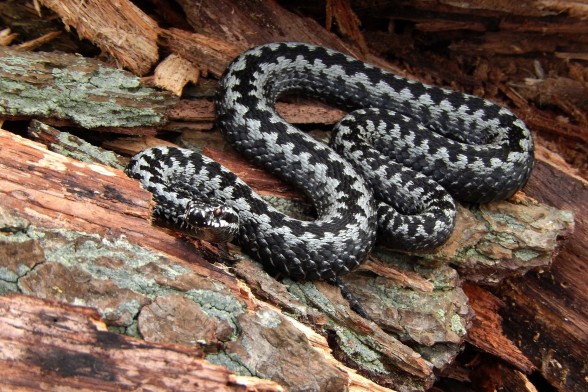
Common European viper
Habitat
The viper usually inhabits grassy and scrubby clearings and woodlands, marshes, pine forests where heather grows, etc. Vipers can also take up residence in abandoned buildings under old building materials. Diet
It feeds mainly on mouse-like rodents and frogs, in spring on young birds, and less often on lizards. The viper bites its prey, waits for its death by poison, and only then begins to devour. The venom not only kills the prey, but also starts the decomposition process. The young snakes feed on insects, less often on molluscs and earthworms.
Important and interesting facts
The viper is the only venomous snake in Latvia. The viper is not aggressive and usually avoids contact with people. Snakes are deaf, they perceive sound through vibrations, so when they sense the vibrations of approaching human footsteps, they try to disappear in time. The viper is the most cold-resistant of all the world’s snakes.
In summer, it loves to crawl out of its hiding place in the morning or afternoon and bask in the sun.
What to do, if you have bitten by a viper?
The main thing to bear in mind is to try as much as possible to reduce the blood flow rate to minimise the spread of the poison through the body. Under no circumstances should you start running after a snake bite – it will speed up the blood circulation and the venom will spread more rapidly. It means that you should try to walk as calmly and slowly as possible to your car and seek medical help or call an ambulance yourself by dialling 113.
If a child has been bitten – never let them walk on their own to avoid speeding up the circulation – carry the child on your hands and seek medical help immediately.
What NOT TO DO if you or someone else is bitten by a snake
Do not run! – Thus you will speed up blood circulation and will increase the chances of the poison spreading more quickly through the body.
Do not apply a tourniquet! Although often discussed as a solution, the use of a tourniquet is a myth and can end badly. If a snake bites your leg, the venom spreads slowly through the body and gradually dissolves, its concentration decreases. But in the case of strangles, the venom accumulates in full concentration at the strangle and later enters the human body at full capacity, which can be much more dangerous.
Do not drink alcool or coffee! Alcohol as a miracle cure for inflammation, poisoning etc. is another myth that can be fatal. Never try to dilute your fears and snake venom by drinking alcoholic beverages! Also, caffeine can speed up the heart rate and is therefore not recommended.
Don’t suck out the venom! This technique used to be considered correct a few decades ago, but the method of cutting and sucking the poison has been much studied and research shows that it is counterproductive because the poison usually spreads too quickly through the body to have any hope of sucking out enough. Cutting the wound, on the other hand, can only cause further tissue damage and risk of infection.
Do not touch or scratch the wound! It is better to remove all tight clothing if a swelling starts to form. Take care to keep the wound intact until you reach the medics.
Information sources: latvijasdaba.lv, Wikipedia; www.1188.lv
Photos: redzet.eu, pixabay.com

